High-Performance Cold Storage Roof Design
Membrane
The roof membrane will need to provide protection against the damage caused by heat, weather elements, and UV rays. The membrane chosen should have the appropriate levels of puncture resistance, particularly for buildings where there will be increased traffic on the roof due to maintenance of cooling equipment. For roof membranes facing the risk of hail, the membrane should be a higher performance reinforced membrane as part of an assembly that has the appropriate hail rating.
The selected membrane should also demonstrate dimensional stability, which means that the material will not shrink over time. Materials that are prone to shrinkage will pull away from vulnerable areas such as at parapets, where the roof deck to parapet wall interface is a crucial interface to limit air infiltration into the assembly.
Selecting a reflective white membrane can help to reduce building cooling costs by lowering the roof’s ambient temperature. Reflective membranes will reflect the sun’s rays and will prevent the heat from entering into the building. Using a lighter colored roof can decrease the urban heat island effect in cities and also may decrease the amount of heat that is able to radiate into a building’s interior.
Membrane seam strength is another area of analysis. Membranes typically feature either welded, taped or glued seams. Heat-welded seams tend to provide better long-term performance over taped seams as welding creates a monolithic material and the seam becomes the strongest point of the membrane. Glued or taped seams over time can lose adhesion and can create points on the roof that are susceptible to water infiltration—and in the case of cold storage facilities—air infiltration.
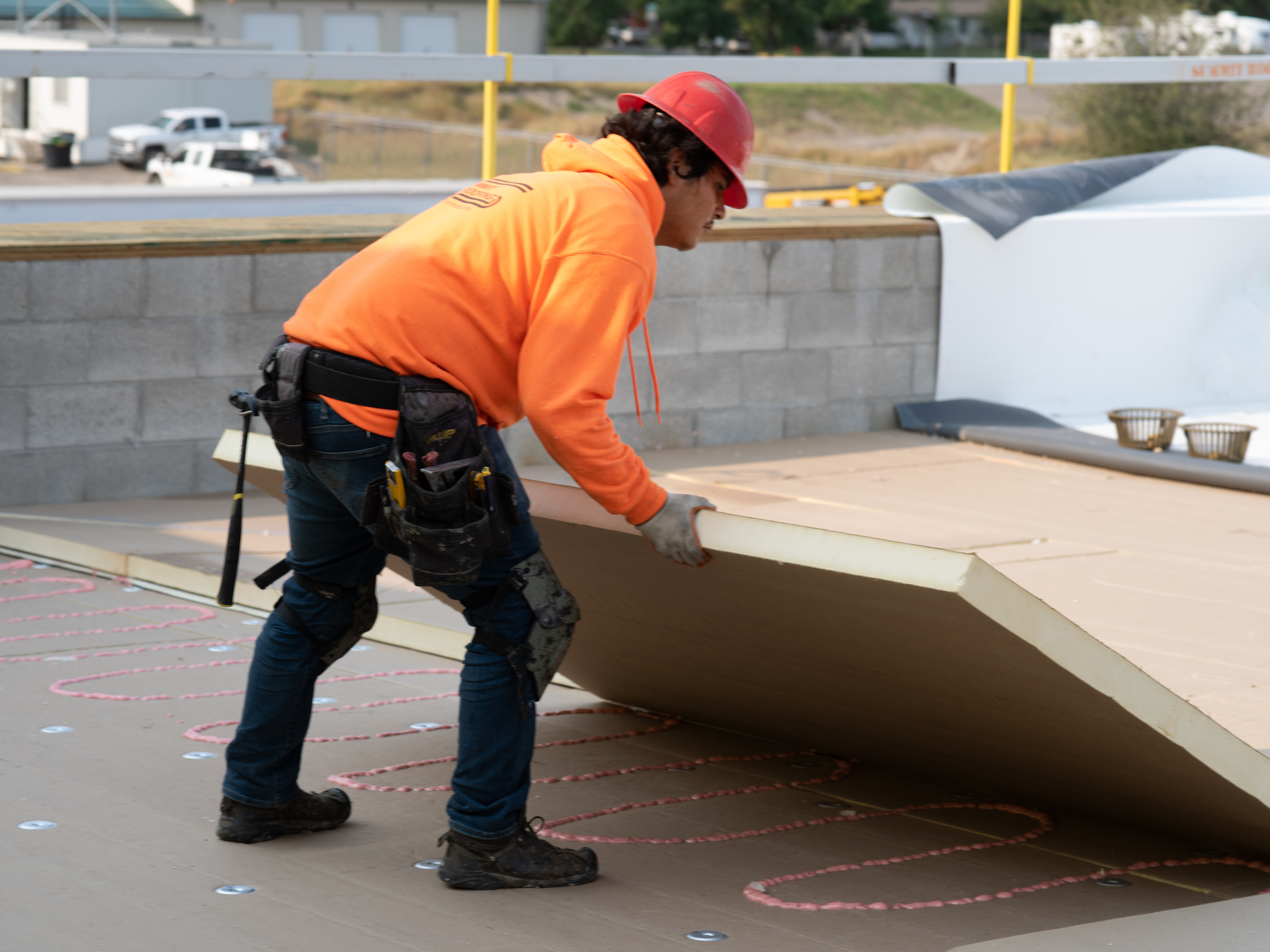
Installing insulation. Insulation is critical in roofing assemblies for overall energy efficiency of the building.
Insulation
Insulation plays a critical role in the building enclosure performance of a cold storage building. To minimize the potential for interior condensation, appropriate amounts of insulation should be used so that the interior effectively maintains the cooling set points. Insulation type should be evaluated for R-value and other desired material properties such as water vapor permeance, water absorption, and compressive strength.
When selecting insulation for a cold storage roof, there are many choices available. Each one has different characteristics and properties. Generally, possible insulation choices include polyisocyanurate (polyiso), expanded polystyrene (EPS), extruded polystyrene (XPS), mineral wool, and lightweight insulating concrete (LWIC). Make sure that the insulation selected is a good fit for the entire roof system, is compatible with other systems, and meets required code.
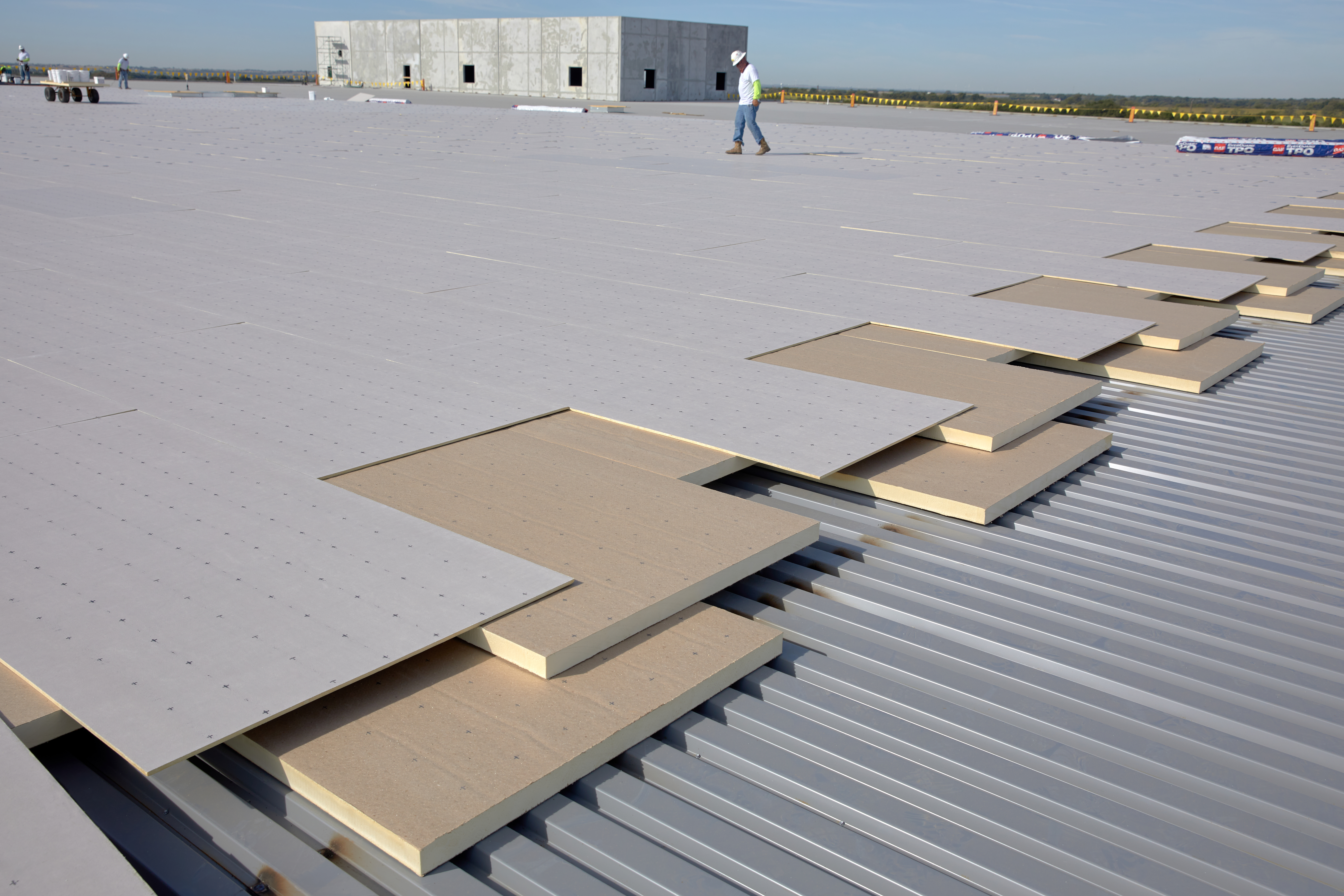
Insulation boards are staggered and offset to prevent aligned joints from forming a clear path for any air and moisture intrusion.
Insulation is critical in roofing assemblies for overall energy efficiency of the building. The higher the R-value, expressed per inch, the better the thermal performance of the insulation and its effectiveness at maintaining interior temperatures. Higher R-value per inch means less material is required to achieve the desired insulating value. Insulation boards are required by code to be installed so that the joints are staggered and offset, and several layers of insulation should be installed rather than just one thick layer. To enhance thermal efficiency, plan for multilayer insulation, where fasteners are buried within the system. Designs with the first layer mechanically attached and the upper layers adhered are shown to be most effective for cold storage roofs. Staggering and offsetting the insulation board joints prevents a clear path for any air and moisture intrusion.
It is the designer’s responsibility to determine the appropriate amount of roof insulation. The 2018 edition of the American Society of Heating, Refrigerating and Air-Conditioning Engineers’ (ASHRAE) ASHRAE Handbook—Refrigeration, is a resource where R-values are recommended by interior temperature. In general, the colder the interior temperature, the more insulation is recommended.
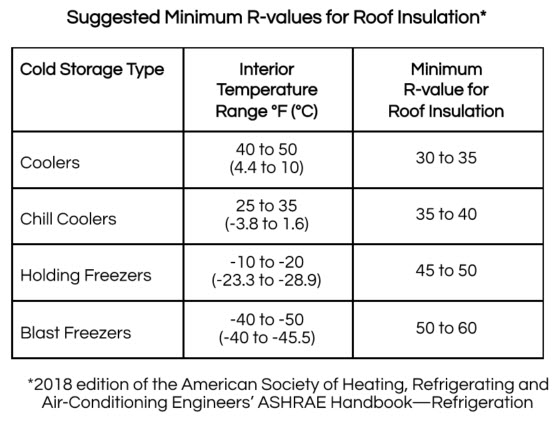
ASHRAE suggested minimum R-values.
Coverboards
Inclusion of a coverboard must be considered during roof assembly material selection. Cold storage roof assemblies generally have increased foot traffic on the roof due to the presence of cooling equipment that is often located on the roof. Coverboards not only provide added protection against foot traffic, but also penetrations, including from tools dropped by service contractors and wind-borne debris. If hail is a concern, there are various coverboards that provide hail ratings for Severe Hail to include high-density polyiso and gypsum based roof boards, as well as Very Severe Hail to include glass mat boards.
Roof attachment method
The attachment method of the roof assembly, whether mechanically attached or adhered, should be evaluated during the design phase and align with performance expectations. As part of determining the attachment method, the effects of the attachment method as it relates to the energy efficiency of the system should be reviewed. As such, identifying thermal shorts and the reduction or elimination of thermal bridges are vital considerations. Thermal bridging occurs when heat passes through a material that is more conductive than the surrounding materials. Insulation is great for reducing heat flow, but the mechanical fasteners that are used to install roof assemblies are great conductors of heat, and can reduce the overall effectiveness of the surrounding insulation.
To reduce the effects of thermal bridging between the gaps between insulation boards, roof insulation should be installed in at least two layers with offset joints to minimize air leakage and movement. Likewise, to reduce the effects of thermal bridging from mechanical fasteners, fasteners should be buried within the system. The first layer of insulation, that is the layer in direct contact with the roof deck, may be mechanically attached. However, subsequent layers should be installed with adhesives to avoid thermal bridging caused by fasteners that are installed through the entire assembly. It is also recommended that the coverboard and roof membrane be adhered to the insulation. Relying solely on mechanical fasteners as the securement method for a roof assembly, or at the upper layer of rigid board insulation, allows thermal bridging to occur and is less energy-efficient. Energy efficiency equates to the cooling equipment not having to run as often to maintain interior temperatures, which will save the building in operating costs.
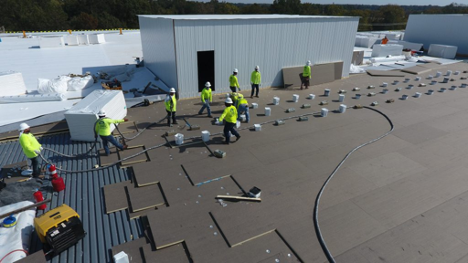
Photo courtesy of Sun Roofing Co.
The first layer or layers of insulation, including the layer in direct contact with the roof deck, may be mechanically attached. Subsequent layers of insulation should be installed with adhesives to avoid thermal bridging caused by fasteners.
Additionally, mechanically attached single-ply systems are subject to billowing in high-wind events. Billowing, or fluttering of the membrane, occurs when wind creates a negative pressure on the roof and creates an uplift force on the roof membrane. The mechanically attached membrane, which is only fastened at the seams (every 10 to 12 feet) will uplift between the seams. Over time, billowing can cause stress and fatigue on the mechanical attachments and membrane. Additionally, piping on the roof for mechanical equipment is often not designed for such movement over time. The piping may also experience stress and fatigue due to movement which could decrease their service lives.
Details
In the end, a successful project all comes down to the details; and the details of a cold storage roof are critical in preventing air and vapor transmission. The forces of moisture and vapor drive, thermal control, and air infiltration come together at the intersections of systems and penetrations.
Under the 2015 International Energy Conservation Code (IECC) Section C103.2.1, including more recent versions of the code, the building’s thermal envelope must be represented on the construction documents. The IECC code regulates the design and construction of buildings for the effective use and conservation of energy over the useful life of each building. Beginning at the large scale, a cold storage building should have an uninterrupted, continuous building enclosure across all size sides of the building. This means verifying across the entire building that all interconnected materials and systems are sealed and connected as required to properly minimize air leakage into or out of the building enclosure. Designers can use the “pen test” to trace the continuous layers for each detail, without picking up the pen from the paper, focusing on the perimeters and penetrations. Each layer, such as water, thermal, and air, should be interconnected from the roof to the walls, to below the slab. The pen test will identify gaps between materials that will allow for thermal bridging, water infiltration, or air infiltration.
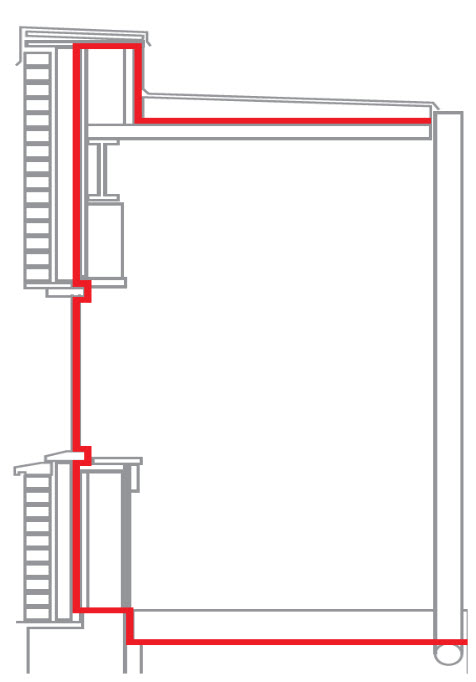
Using a “pen test” verifies that all materials and systems are properly interconnected and sealed, preventing air leakage.
The roof on most cold storage structures acts as both the vapor-control layer and the air-control layer for cold storage buildings. Keeping adjoining systems connected and getting details correct ensures success or failure of the roof assembly. Details must be provided for joints, penetrations, and transition areas, and ensuring these details are airtight is paramount.









